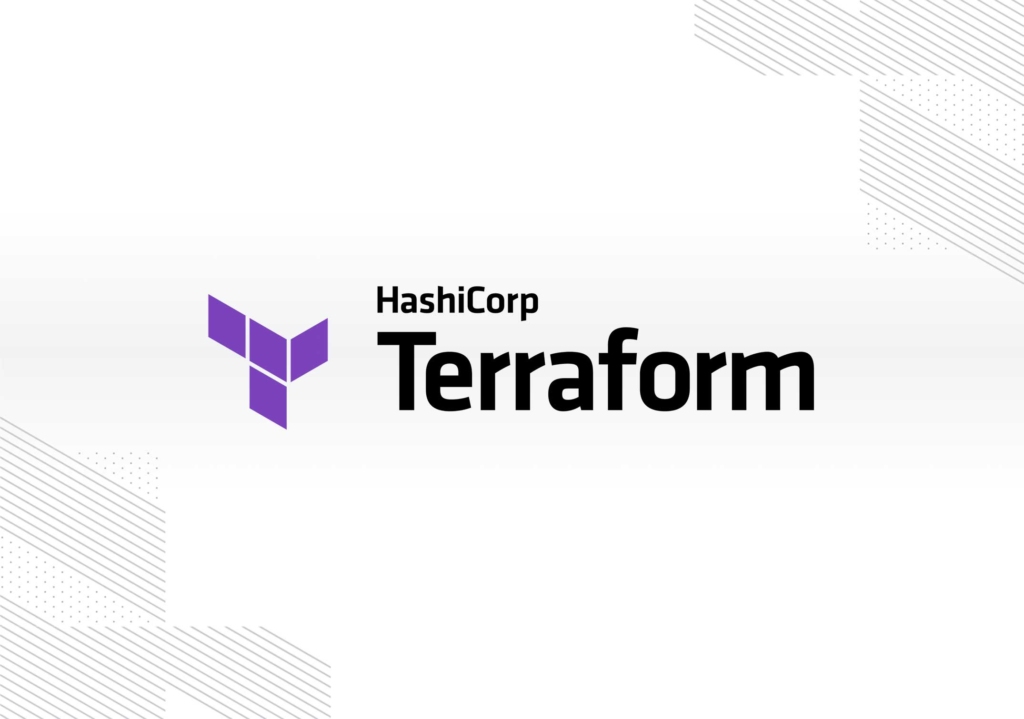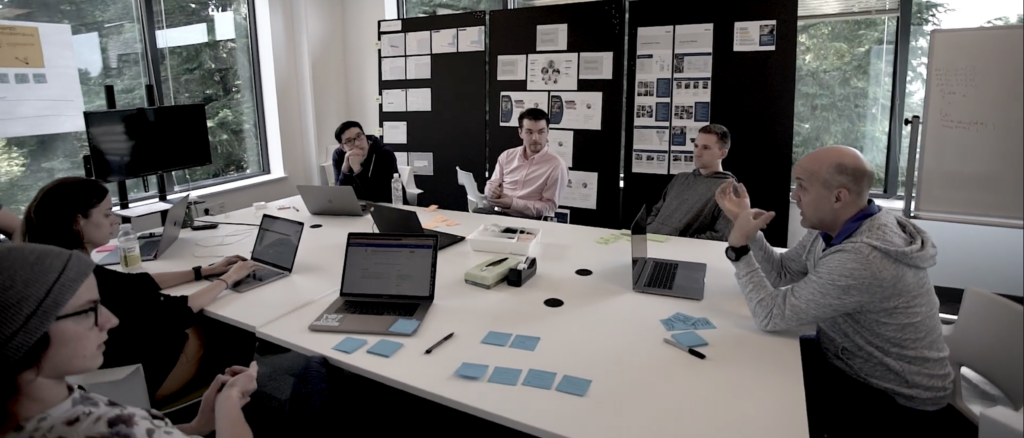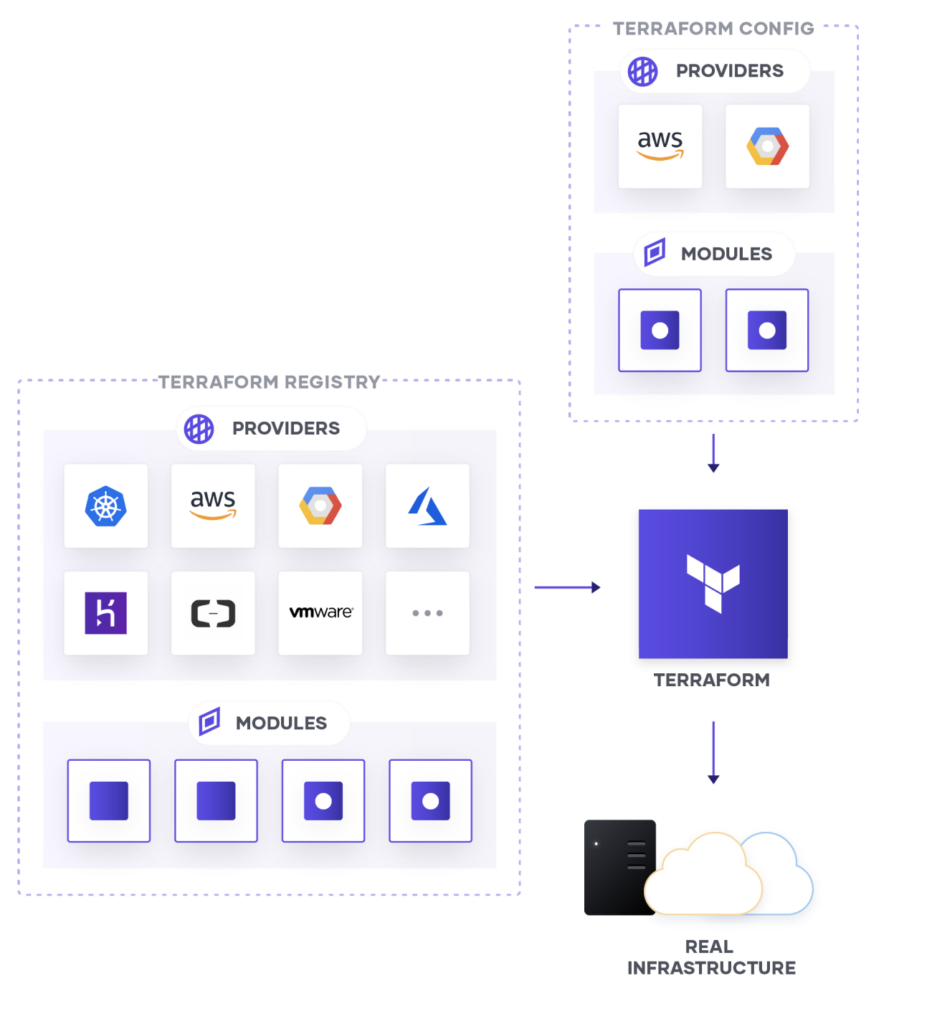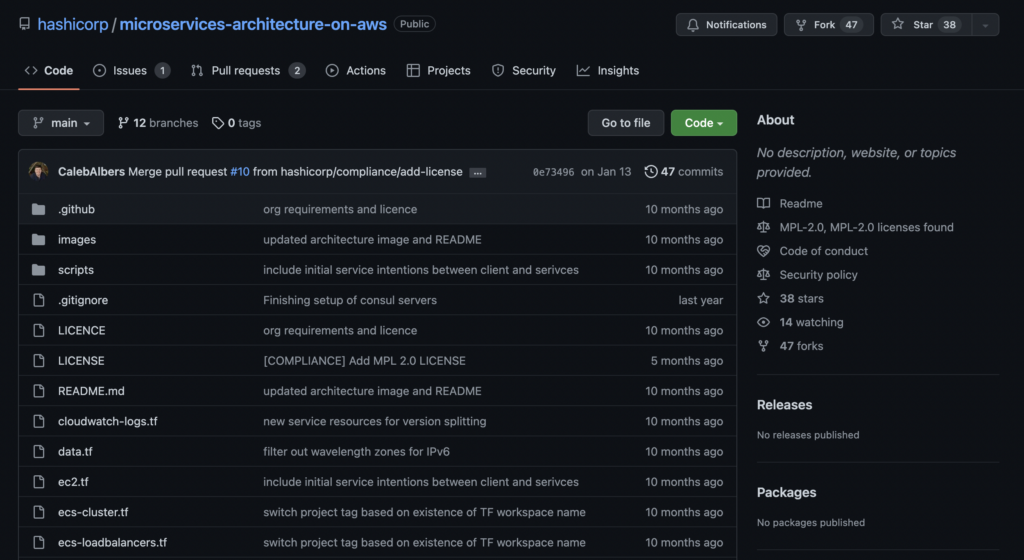Article
Using Terraform to Overcome Critical Cloud Challenges

Terraform is a software tool that drastically simplifies building cloud infrastructure with security tools, cost-effective resources, and optimized workflows. Empowering development teams to treat “infrastructure as code,” Terraform enables configurations and changes to be version controlled, audited, and replicated, rather than requiring a team to use web interfaces to configure cloud and on-premise infrastructure.
Due to its various strengths, Terraform is thriving as the tool of choice across a variety of industries. Hashicorp, Terraform’s parent company, reports that more than 15% of the Fortune 500 use Terraform Cloud, evidence of its rising popularity and the fact that it’s worth considering as a platform for cloud development.
At Fresh, we focus on building services that help clients build a foundation for exponential growth. The tools we choose are essential to that mission. Our end-to-end software development teams provide a range of services including cloud architecture, enterprise system development, and AI/ML that leverage cloud management tools like Terraform to solve business challenges. Whether your use case is formalizing Dev-Ops practices, conducting multi-cloud deployments, revamping your existing technology architecture, and bolstering cloud security, a tool like Terraform can help.
Let’s dive more into the specifics of how Terraform can generate exceptional value for the companies that choose it.

3 critical cloud challenges and how Terraform solves them
We took a deep dive into the Flexera 2022 State of the Cloud Report, an annual survey understanding the current cloud landscape, the significant challenges, and how organizations tackle the complexities of the cloud. Flexera’s findings about the top challenges businesses face regarding their cloud strategy match up with what we’ve seen in working with clients across a broad spectrum of industries:
- Security: cybercrime, data breaches, and the need to pass audits
- Cost: wasteful spending, inefficiencies, and excess processes
- Lack of Resources and Expertise: need predefined processes that work out-of-the-box and can be customized to the business
“Infrastructure as Code” helps organizations proactively address cloud security
According to a report from Thales, nearly half of all organizations either experienced a data breach or failed an audit relating to cloud data in the past year.
With cloud adoption increasing and cybercrime rising, security is more important than ever.
The realities of business commitments and competing priorities sometimes make it feel impossible to give cloud defense enough attention. Fortunately, “security vs. business development” is a false dichotomy. And with a tool like Terraform, organizations can have both simultaneously while eliminating bottlenecks in the deployment process.
Terraform’s “Infrastructure As Code” capabilities automate elements of cloud security
Manual security, compliance checks, and resource provisioning are slow, cumbersome, and prone to human error. Some companies opt to bypass parts of this essential workflow to speed up deployments, but it’s rarely worth it: the average cost of a data breach in the United States is over 9 million dollars.
Other common challenges with manual workflows include:
- Antiquated infrastructure: As development teams become larger and more globalized, there’s a pressing need for self-service infrastructure deployment.
- Slow delivery: The acceleration of new products and customer experiences is essential for businesses, and traditional approaches struggle to keep up with the demand.
- Disparate structures: While disparate structures might work when a company is smaller, growth necessitates integrating disparate infrastructure into unified, all-encompassing solutions.
With Terraform, infrastructure and policies are codified, shared, managed, and executed within a consistent workflow across all infrastructure, which is useful for:
- Simplicity: Terraform can make it easier to navigate a complex transition with pre-built templates.
- Code review: Terraform’s “infrastructure as code” approach enables infrastructure to be reviewed and tested as part of CI/CD.
- Automation: Terraform automates slow, error-prone manual processes, allowing organizations to scale their IT infrastructure more quickly and efficiently.
Through automation, Terraform can actually make your security processes more robust by centralizing cloud governance models and enforcing cloud security policy with simple-to-write Terraform plans.
Example Use Case: Standardizing Access Control Policies
Startups often struggle to define their cloud strategy. In light of the demands for growth and infrastructure development, challenges can include:
- Rapid onboarding. When new members join a team or employees start on a new project, it often takes days to access the resources they need to deliver impact. This can swamp Central IT with access requests and cause them to start missing SLAs on other, more pressing tickets.
- Excessive access. To address sinking productivity and exploding tech debt, IT and engineering departments sometimes deal with the growth challenge by granting broader access to employees so they can do their job.
- Lack of visibility. When employees are granted excessive access to cloud resources, access levels are often beyond the scope needed to complete a job. Tracking access and revoking access are essential when employees move teams or finish a project.
- Increased outages and incidents. Broader access doesn’t equate to increased velocity. Outages and incidents increase without an established access policy, and it can be challenging to identify where the disconnect is happening.
In scenarios like this, a software development team has good intentions (quick production, delivering value, etc.), but needs agreed-upon direction (avoiding excessive access, ensuring deployed changes are effective, etc.). Without direction, the risk to security is clear: mistakes inevitably arise with incorrect access control settings, causing undue expenses, stress, and productivity challenges.
Terraform’s “Infrastructure as Code” automates the approval process according to codified best practices.
Imagine a company in the above scenario. They want to maintain engineering velocity. It’s essential that any cloud architecture changes support their current rapid deployment model while addressing their critical access control challenges and languishing productivity.
A configuration management tool like Terraform is vital to help scale cloud operations while also handling access control issues automatically. The company could define its access control policies and codify them in Terraform. They can also write integration tests to test any changes to the Terraform plan before deployment.
Results:
- Cloud policy is clearly defined in a written Terraform plan.
- Any changes to cloud policy in Terraform must be code reviewed as part of a pull request. No more accidental breaking infrastructure changes!
- Better visibility into access control policies defined in Terraform.
- By default, team members have the right level of cloud access.
Benefits:
- Increase productivity––no more constant access control requests.
- Increase stability––no more employees accidentally breaking things they weren’t supposed to have access to.
- Increase reliability––cloud configuration changes must pass integration tests before deployment.
A Terraform solution like this benefits companies in numerous areas of their multi-cloud infrastructure. It provides the foundation to create a robust cloud strategy that increases productivity, reduces spending, and most importantly in this scenario, helps organizations proactively address cloud security issues.

Spending is on the rise, and Terraform’s suite of tools can help cut costs
Respondents of the 2022 State of the Cloud Report estimate that 32% of their organizations’ cloud spending is wasteful. Effective cost management and efficient tooling are key as cloud spending increases.
The Flexera researchers conclude that automation is one of the most practical ways to reduce cloud spending, but many companies still need to automate their cloud policies––and do so strategically. Terraform’s infrastructure-as-code platform is a great way to get the means of automation in place.
Terraform’s suite of tools simplify the process of automation
Without an efficient, reliable, and scalable way to set up resources, organizations face various challenges including:
- Slow processes: Unpredictable lead time and delays result from undefined workflows, and there’s a critical need to avoid slowdowns in light of the pace of modern business.
- No centralized logs: When using multiple workflows, preventing drawn-out compliance checks and incident response procedures is essential.
- Ill-managed, multiple code bases: Code should avoid redundancy and be easy to reuse; without predefined workflows, there’s more risk of discrepancies in code quality.
- Different versions of code: In agile software development workflows, avoiding developer confusion and unnecessary workflow friction is vital.
Terraform’s ability to integrate with existing processes is useful because it enables:
- Faster Turnaround: Terraform reduces the time needed for infrastructure deployments––often from days to hours
- Optimization: Terraform drastically increases the number of updates you can deploy within a timeframe.
- Standardization: Terraform’s setup works the same way in any environment.
Terraform can help reduce cloud spend by allowing engineers to standardize cloud configuration. Companies can create cost-conscious policies that get automatically deployed as part of CI/CD pipelines.
Example Use Cases: Shutting Down Unused Machines via Terraform Policy
Companies with an existing infrastructure incur technical debt over time. Common infrastructural challenges include:
- Inefficient tooling. A mix of on-premises infrastructure and cloud infrastructure, all managed with different tools including scripts, GUIs, web portals, and more. Most of it isn’t documented and relies on tribal knowledge to operate.
- Poor resource management. Nobody’s entirely sure what all the resources are for. The company is afraid to turn anything off––last time they tried, it caused an expensive outage because it turned out that a machine was required.
- Ballooning spending. The company’s growth, combined with the challenges of maintaining its infrastructure, creates a costly result. The finance department is looking for answers, but the engineering team doesn’t have them.
Terraform’s various tools can automate the process of shutting down resources, saving extensive time and effort.
Terraform has the potential to reduce infrastructure spending through setting a policy to automatically shut down resources after a certain amount of time has passed and creating scalable approaches to creating new resources:
- You can set a TTL (Time to Live) variable for your resources in your Terraform configuration. Then, you can create a mechanism to check your resources and destroy resources that have outlived their TTL. The company has a long way to go in modernizing its infrastructure management, but codifying its resource policy in Terraform to save money is a great start.
- Terraform Registry, a key feature of the platform, provides predefined workflows that make adopting new processes easier, saving businesses time with a semi-customizable off-the-shelf solution. One clear-cut is that the predefined workflows integrate well with a team’s existing processes. Teams can operate it via API, CLI, and UI, which allows organizations to integrate it easily into their existing CI/CD pipelines, IT service management interfaces, and version control system processes. This level of integration with existing workflows minimizes process changes, streamlines the process of getting up and running, and ensures consistency throughout.
Results:
- Infrastructure policy is clearly defined in a written Terraform plan.
- Engineering and finance departments can align their goals with one tool.
- Room to grow their Terraform and cloud strategy.
Benefits:
- Cost savings––no more paying for resources you’re not using.
- Easy to change––if you need to extend the lifetime of resources, it just takes one quick code change.
- Automated––no IT ticket-based approach.
This in-depth guide from Hashicorp covers the specifics of AWS implementation. If you use a different cloud or multi-cloud strategy, the same principles apply.

Terraform’s predefined workflows can leverage an organization’s lack of expertise and resources
The Flexera State of the Cloud researchers reported that over 80% of companies surveyed cited “lack of resources and expertise” as a top concern about their cloud strategy.
Terraform enables cloud deployments within a single workflow
As organizations move to the cloud, they deal with common issues like cumbersome manual workloads for central IT, slow ticketing systems, slow manual workflows for developers, a lack of consistent policy enforcement, and unscalable infrastructure. These issues manifest in challenges like:
- Difficult to control code changes: With traditional approaches, there’s a need for “approval gates” and other forms of standardization, which aren’t optimized for agile workflows.
- Lack of self-service: Traditional, undefined workflows can take multiple days, or even weeks, to prepare environments.
Terraform lets you use the same workflow to manage multiple providers and handle cross-cloud dependencies. Using a single workflow simplifies management and orchestration for large-scale, multi-cloud infrastructure, making Terraform deployment more streamlined through:
- Standardization: Terraform enables teams to integrate a standard set of policies to apply across all cloud infrastructure, regardless of platform, significantly optimizing a team’s workflow.
- Automation: Terraform offers predefined workflows that run during critical moments in deployment to speed up engineering velocity, no matter how many cloud platforms your company uses.
Terraform has options for out-of-the-box (but editable) workflows to keep development consistent
Terraform can help resource-strapped companies get their cloud strategy off the ground with a library of predefined plans on the Terraform Registry. The plans work out of the box, so this is a great starting point for teams that still need cloud experience to build workflows manually; however, the existing workflows are also customizable, enabling companies with unique needs to adjust as required.
Example Use Case: A Terraform template for new microservices
Large companies are increasingly augmenting their software with cloud-based microservices. The primary benefits of a microservice architecture––compared to a monolithic architecture––include reusability and scalability. However, there can be challenges, especially if the business doesn’t yet have a mature, well-established cloud team:
- Upfront deployment costs. There’s a cost to the initial deployment of a microservice, both in engineering time and infrastructure costs.
- Duplicated work. Every time a team builds a new microservice, they perform the same tasks to configure and deploy it. This takes away from engineering time on other projects.
- Setup mistakes. Humans inevitably make manual errors. The same is true during the microservice setup process, and the risk increases with each microservice.
- Tribal knowledge. A team member who hasn’t done the microservice setup before won’t know if there are any undocumented steps they need to perform.
Creating a standard microservice Terraform plan creates alignment, saves time, and empowers developers to do better work
A new cloud team might need help with the high overhead for new microservices and the lack of human resources to address it. To streamline the process, they look to Terraform and create a standardized plan for each microservice. They find an example on the Terraform Registry and make it work for their business case.
Results:
- A standard microservice definition is codified in a written Terraform plan.
- All microservice deployments can be code-reviewed and integration-tested.
Benefits:
- Decrease time-to-deployment––no more wasting engineering resources on doing the same setup tasks
- More straightforward setup––no specialized knowledge is required to deploy a new microservice.
- Reusable template––APIs and documentation are more likely to stay up to date since they’ve all come from the same template.
Here’s an official example from Hashicorp on how to create an AWS microservices architecture using Terraform.

Do you need assistance with Terraform development? Let’s get started.
At Fresh, we often say we’re “end-to-end.” Our software development efforts start from phase zero when we begin thinking holistically about your business challenges and how software can help. Our cloud architects help you evaluate the components and structure you need for your cloud deployments. Then, using tools like Terraform, we design solutions that position you for exponential digital growth while adhering to the highest standards for security.
We’ve seen the value of infrastructure as code firsthand, and Terraform is one of the leading technologies to accomplish this. Whether you need support with Terraform or something else related to software development, we would love to connect and discuss the possibilities.
We look forward to hearing from you!









